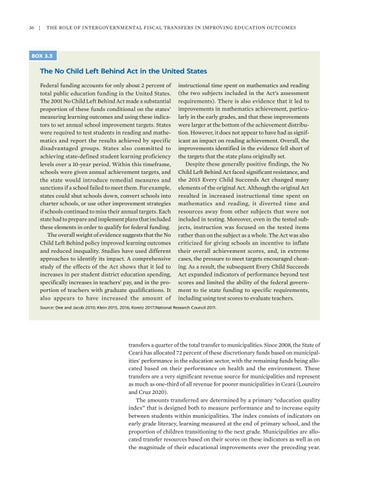36 | The Role of Intergovernmental Fiscal Transfers in Improving Education Outcomes
BOX 3.3
The No Child Left Behind Act in the United States Federal funding accounts for only about 2 percent of total public education funding in the United States. The 2001 No Child Left Behind Act made a substantial proportion of these funds conditional on the states’ measuring learning outcomes and using these indicators to set annual school improvement targets. States were required to test students in reading and mathematics and report the results achieved by specific disadvantaged groups. States also committed to achieving state-defined student learning proficiency levels over a 10-year period. Within this timeframe, schools were given annual achievement targets, and the state would introduce remedial measures and sanctions if a school failed to meet them. For example, states could shut schools down, convert schools into charter schools, or use other improvement strategies if schools continued to miss their annual targets. Each state had to prepare and implement plans that included these elements in order to qualify for federal funding. The overall weight of evidence suggests that the No Child Left Behind policy improved learning outcomes and reduced inequality. Studies have used different approaches to identify its impact. A comprehensive study of the effects of the Act shows that it led to increases in per student district education spending, specifically increases in teachers’ pay, and in the proportion of teachers with graduate qualifications. It also appears to have increased the amount of
instructional time spent on mathematics and reading (the two subjects included in the Act’s assessment requirements). There is also evidence that it led to improvements in mathematics achievement, particularly in the early grades, and that these improvements were larger at the bottom of the achievement distribution. However, it does not appear to have had as significant an impact on reading achievement. Overall, the improvements identified in the evidence fell short of the targets that the state plans originally set. Despite these generally positive findings, the No Child Left Behind Act faced significant resistance, and the 2015 Every Child Succeeds Act changed many elements of the original Act. Although the original Act resulted in increased instructional time spent on mathematics and reading, it diverted time and resources away from other subjects that were not included in testing. Moreover, even in the tested subjects, instruction was focused on the tested items rather than on the subject as a whole. The Act was also criticized for giving schools an incentive to inflate their overall achievement scores, and, in extreme cases, the pressure to meet targets encouraged cheating. As a result, the subsequent Every Child Succeeds Act expanded indicators of performance beyond test scores and limited the ability of the federal government to tie state funding to specific requirements, including using test scores to evaluate teachers.
Source: Dee and Jacob 2010; Klein 2015, 2016; Koretz 2017;National Research Council 2011.
transfers a quarter of the total transfer to municipalities. Since 2008, the State of Ceará has allocated 72 percent of these discretionary funds based on municipalities’ performance in the education sector, with the remaining funds being allocated based on their performance on health and the environment. These transfers are a very significant revenue source for municipalities and represent as much as one-third of all revenue for poorer municipalities in Ceará (Loureiro and Cruz 2020). The amounts transferred are determined by a primary “education quality index” that is designed both to measure performance and to increase equity between students within municipalities. The index consists of indicators on early grade literacy, learning measured at the end of primary school, and the proportion of children transitioning to the next grade. Municipalities are allocated transfer resources based on their scores on these indicators as well as on the magnitude of their educational improvements over the preceding year.






